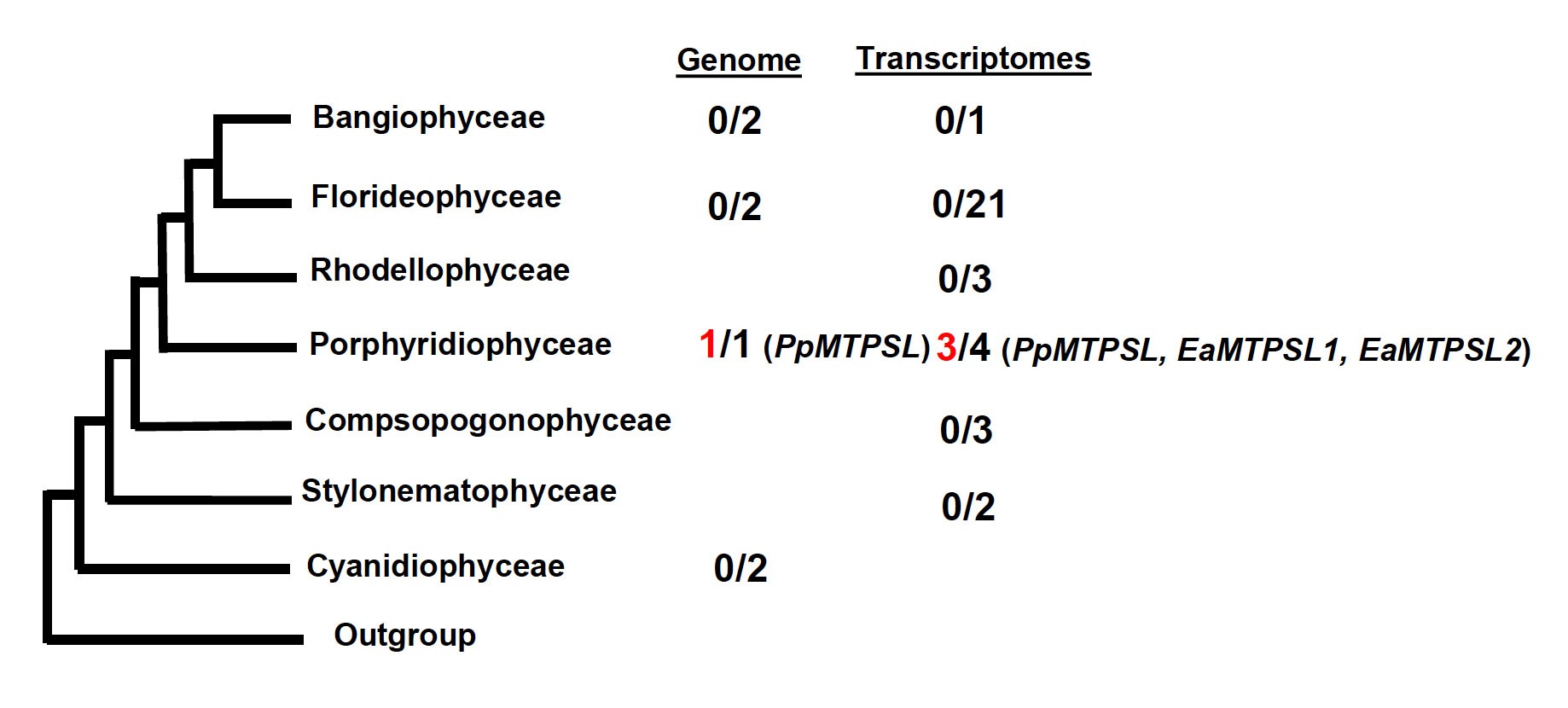博文
Plant Physiology:红藻萜类生物合成TPS酶与陆地植物不一样
||
Terpene Biosynthesis in Red Algae is Catalyzed by Microbial Type but not Typical Plant Terpene Synthases
First author: Guo Wei; Affiliations: University of Tennessee (田纳西大学): Tennessee, USA
Corresponding author: Feng Chen
Red algae (Rhodophyta) and land plants belong to the monophyletic clade Archaeplastida and taxa of both groups are rich producers of terpene secondary metabolites. The terpene carbon skeletons of land plants are made by two types of terpene synthases: typical plant terpene synthases and microbial-type terpene synthases (MTPSLs); however, terpene biosynthesis in red algae is poorly understood. By systematic sequence analysis of seven genomes and 34 transcriptomes of red algae, MTPSL homologs were identified within one genome and two transcriptomes, whereas no homolog of typical plant terpene synthase genes was found. Phylogenetic analysis showed red algae MTPSLs group with bacterial terpene synthases. Analysis of the genome assembly and characterization of neighboring genes demonstrated red algal MTPSLs to be bona fide red algal genes, and not microbial contaminants. MTPSL genes from Porphyridium purpureum and Erythrolobus australicus were characterized via heterologous expression in Escherichia coli and demonstrated to have sesquiterpene synthase activities. We detected a number of volatile sesquiterpenes in the headspace of P. purpureum and E. australicus cultures, most identical to the in vitro products of the respective MTPSLs. Expression of the MTPSL gene in P. purpureum was found to be induced by methyl jasmonate, suggesting a role for this gene in host defense. In summary, this study indicates that the formation of terpene carbon skeletons in red algae is carried out by MTPSLs that are phylogenetically unrelated to typical plant terpene synthases, and most likely originated in Rhodophyta via horizontal gene transfer from bacteria.
红藻和陆地植物属于单系起源的原始色素体生物Archaeplastida,这两者所包含的物种均富含萜类次生代谢物。陆地植物萜类物质的碳骨架由两种类型的萜类合酶合成,一种是典型的植物萜类合酶,另一种是微生物类萜类合酶MTPSL;然而,红藻中的萜类生物合成还不是很清楚。通过7个红藻基因组和34个红藻转录组的系统序列分析,作者在其中一个基因组和两个转录组数据中鉴定到了MTPSL同源物,并未鉴定到典型植物萜类合酶基因。系统发育分析显示红藻MTPSL与细菌萜类合酶聚为一支。通过对基因组组装和临近基因的分析显示红藻的MTPSL确实是红藻上的基因,并不是微生物污染。作者通过在大肠杆菌中异源表达淡色紫球藻和红藻的MTPSL基因显示其具有倍半萜烯合酶的活性。作者在淡色紫球藻和红藻培养体系顶部检测到了一些不稳定的倍半萜烯,该结果与各自MTPSL在体外的产物一致。淡色紫球藻中MTPSL基因的表达受到茉莉酸甲酯的诱导,说明该基因可能参与了寄主的抗性。综上,本文的研究揭示了红藻中的萜类碳骨架形成是由与典型植物萜类合酶不同的MTPSL所控制的,这些MTPSL很有可能是红藻通过基因水平转移从细菌中整合而来。
通讯:Feng Chen (https://gst.tennessee.edu/people/feng-chen/)
个人简介:1994年,南开大学,分子生物学学士;1997年,中科院,遗传学学士;2000年,加州大学戴维斯分校,植物生物学博士。
研究方向:植物次生代谢物。
doi: https://doi.org/10.1104/pp.18.01413
Journal: Plant Physiology
First Published: 11 December, 2018
https://blog.sciencenet.cn/blog-3158122-1151484.html
上一篇:Genome Biology:草莓成熟过程中RdDM下调作用于DNA低甲基化
下一篇:PLOS Genetics:拟南芥RBR1基因全基因组范围的结合位点鉴定
全部作者的其他最新博文
- • Plant Physiology:CsMADS3促进柑果中的叶绿素降解和类胡萝卜素合成(华中农业大学)
- • Molecular Plant:LBD11-ROS反馈调节作用于拟南芥的维管形成层增殖和次生生长(浦项科技大学)
- • Science Advances:根结线虫通过调控植物的CLE3-CLV1模块,促进侵染进程(日本熊本大学)
- • Nature Communications:油菜素内酯参与植物营养生长期转变的分子机制解析(浙江农林大学)
- • Current Biology:光合作用产生的蔗糖驱动侧根“生物钟”(德国弗莱堡大学)
- • PNAS:花同源异型基因在叶中被抑制、花中被激活的分子机制(南卡罗来纳大学)

